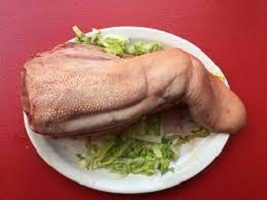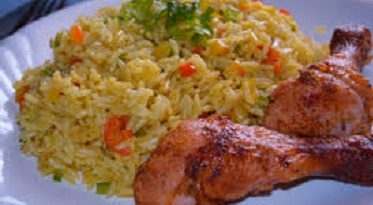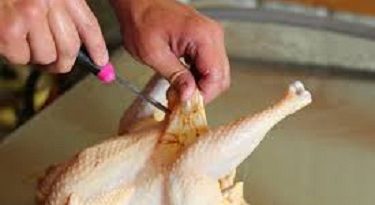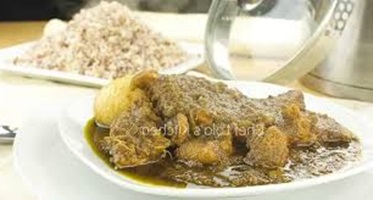How to Clean Cow Tongue: How to Cook Beef Tongue
How to Clean Cow Tongue before cooking: How to Cook Beef Tongue

Cow tongue is incredibly tasty and juicy; you can use it in any meal, including numerous Nigerian soups and sandwiches, as well as on its own. Unlike certain other portions of beef, the taste will never be damaged no matter how long you cook it.
Related >>>
How to Clean Cow Tongue
Cleaning the tongue of a cow might take anywhere from 20 minutes to four hours. I go with the first option. Please, I don’t have all day to spend in the kitchen.
Note: To make cleaning easier, cut it into steaks.
How to Clean and Cook Cow Tongue – What You Will Require
- Cow tongue
- Hot Water
- 1tsp Salt
How to Clean Cow Tongue – What is the Best Way to Cook Beef Tongue?
Beef tongue is an inexpensive cut of meat that can feed a family. The low price does not imply poor quality. In fact, in less squeamish times, its exquisite flavor made it a desirable item.
Ingredients
- Basic Beef Tongue
- 1 small beef tongue (~3 lb / 1.4 kg)
- Peppercorns
- Onion and carrots (or other vegetables)
- Flour or condensed French onion soup, for a thicker sauce (Optional)
- Bay leaf (or other herbs)
- Tacos de Lengua
- 1 small beef tongue (~3 lb / 1.4 kg)
- Onion, carrots, herbs of your choice
- Lard or oil
- Salsa verde
- Corn tortillas
- Tongue with Raisin Sauce
- 1 beef tongue (~4 lb / 1.8 kg)
- 2 onions
- 1/3 cup (80 mL) white wine vinegar
- 1 clove garlic, crushed
- 1/3 cup Madeira wine
- 2 tablespoons (30mL) butter
- 1 stick celery (with leaves), sliced
- 1/3 cup (80 mL) raisins
- 2/3 cup tongue cooking broth
- 2 carrots, sliced
- 3 tablespoons (45 mL) almonds, chopped
- 1 tablespoon tomato paste
- Salt and pepper to taste
Method on How to Cook Cow Tongue – Simmered Beef Tongue (Basic)
Invest in the tongue: Larger tongues take longer to cook, so go for the smallest one you can find, preferably under 3 pounds / 1.4 kg. The tongue has a short shelf life, so buy it from a reputable butcher extremely fresh or frozen. (Thaw in the refrigerator if frozen for best safety.)
The glands, bones, and fat at the root of the tongue can all be found on some tongues. When cooked, this section is edible, but the mushy, fatty feel is not for everyone.
You can chop it off yourself (before or after cooking), or buy a pre-trimmed “Swiss cut” tongue.
The brined tongue has a richer flavor than the fresh tongue and can be prepared in the same way.
Floss the tongue: Scrub the tongue thoroughly under cold running water in a clean sink. Clean until there is no more dirt or blood on the surface.
Many recipes suggest soaking the tongue for an hour or two in cold water, changing the water as needed.
Although the store-bought tongue is usually clean enough to omit this step, it can help to refresh the flavor.
Make the broth as follows:
Fill a big pot halfway with chick or beef stock or water with a reasonable amount of salt. Vegetables and herbs of your choice can be added.
A simple base consists of onion or two, a couple of bay leaves, peppercorns, and a carrot. Other herbs and spices, such as oregano, rosemary, garlic, or chilies, are optional. Over high heat, bring to a boil.
To expedite the procedure, use a pressure cooker or a slow cooker. Add four cans of condensed French onion soup to make a richer sauce to serve with the tongue.
Finally, add the tongue: Cover the pot and add the tongue to the broth. Allow boiling, then reduce to a low heat.
Maintain total submersion of the tongue. You may need to add more water or use a steamer basket to weigh it down.
Simmer until the tongue is soft, turning white and readily piercing the thickest section with a knife: It takes roughly 50–60 minutes per pound (0.45 kg) of beef to do this.
Please Note:
The tongue becomes harsh and unpleasant as a result of quick-cooking or undercooking.
If you have the time, err on the side of caution and cook for a further hour or two.
If you’re using a pressure cooker, heat it until it steams. Reduce the heat to medium and cook for 10–15 minutes per pound of meat (0.45 kg). Allow cooling until steam naturally escapes.
Peel the tongue while it’s still warm: Using tongs, transfer the tongue to a plate. Cut through the outer white layer longitudinally with a sharp knife after the tongue is just cool enough to touch.
Peel this layer away with your fingertips, cutting as needed. (Though technically edible, this layer has a disagreeable flavor and texture.)
Once the tongue has cooled, peeling it becomes considerably more difficult. However, if it’s already at room temperature, submerging it in ice water can assist.
Beef Tongue Recipe
Make a soup with the broth or use it to spice sauces.
Cut the meat into 1⁄4 inch (0.6 cm) slices: Cut the meat into 14 inches (0.6 cm) slices and serve with salsa verde, on a sandwich with brown mustard and greens, or baked for another half hour with roast potatoes.
There’s a lot of meat, so save some of the larger chunks to grill or use in one of the other recipes. It’s undercooked if the meat is tough. Return it to the broth and continue to cook it on low heat.
By adding flour to a portion of the sauce, you may quickly turn it into a gravy.
Refrigerate any leftovers: In an airtight container in the fridge, the boiled tongue will last for about five days.
People also ask on How to Clean Cow Tongue
Is it necessary to peel the beef tongue?
You must peel the tongue’s skin off while avoiding burning your fingers in the process. The tough part is that if you let it cool too long, peeling off the skin, especially from the bottom of the tongue, becomes quite difficult.
What is the best way to peel a corned tongue?
Place the tongue, along with the salt, in a soup pot with enough water to cover it.
Bring to a boil, then cook for 2 ½ to 3 hours, or until the outer skin begins to peel away. Serve after peeling off the thick outer skin.
What is the price of cow tongue?
Beef tongue is typically priced at roughly $10 per pound. Because most cow tongues weigh roughly 2 pounds, one tongue will cost around $20.
You might expect that an organic, grass-fed beef tongue would be more expensive, yet this is the pricing for all beef tongue on the market.
Is it possible to eat a cow tongue?
The tongue of a cow is eaten all over the world. The tongue can be used to make a variety of dishes, including soups, salads, and sandwiches, and it is widely used around the world.
It’s served on tacos in Mexico, and the dish is known as “Tacos de Lengua.” At Korean or Japanese BBQ restaurants, ray beef tongue is served.
How to Clean Cow Tongue: Cow skin
Cow skin, commonly known as beef tripe, is the edible lining from the stomach of cattle. While it may not be as popular as other cuts of meat, it is consumed in various cuisines around the world.
Here are some potential benefits of cow skin meat:
Rich in Protein:
Like other meat products, cow skin is a good source of high-quality protein. Protein is essential for building and repairing tissues, supporting immune function, and maintaining overall health.
Collagen Content:
Cow skin is rich in collagen, a structural protein that is crucial for maintaining the health of skin, joints, and connective tissues. Collagen is also known to promote skin elasticity and joint flexibility.
Nutrient Density:
Cow skin contains various nutrients, including vitamins and minerals such as iron, zinc, and B vitamins. These nutrients play important roles in various bodily functions, including energy metabolism, immune function, and blood formation.
Potential for Gelatin Production:
Cow skin can be processed to produce gelatin, a substance with various culinary uses. Gelatin is often used in desserts, soups, and various food products. It may also have some health benefits, such as supporting joint health and improving skin condition.
Cultural and Culinary Diversity:
In many cultures, cow skin is used in traditional dishes, adding diversity to the culinary landscape. The preparation and consumption of tripe vary widely, and it is often included in stews, soups, or grilled dishes.
It’s important to note that while cow skin can offer nutritional benefits, it may not be suitable for everyone. Some people may find the taste, texture, or odor unappealing.
Additionally, individuals with certain dietary restrictions or health conditions may need to be cautious about consuming certain animal products.
As with any food, moderation is key, and it’s essential to consider individual preferences and dietary needs.
If you have specific dietary concerns or health conditions, it’s advisable to consult with a healthcare professional or a registered dietitian for personalized advice.
What nutritional benefits does cow skin meat offer?
Cow skin meat, also known as beef tripe, is rich in high-quality protein, essential for tissue repair and immune function. It contains collagen, promoting skin and joint health, and provides essential vitamins and minerals such as iron, zinc, and B vitamins.
How does the collagen in cow skin meat contribute to health?
Collagen is a structural protein found in cow skin meat that supports skin elasticity, joint flexibility, and connective tissue health. Consuming collagen may contribute to improved skin and joint health.
Are there any specific nutrients in cow skin meat that are noteworthy?
Yes, besides protein and collagen, cow skin meat contains essential nutrients like iron, which is important for blood formation, and zinc and B vitamins that play roles in various bodily functions, including metabolism and immune support.
Can cow skin meat be beneficial for those looking to boost their protein intake?
Absolutely. Cow skin meat is a good source of protein, making it a valuable addition to a diet aiming to meet protein needs. Protein is crucial for muscle maintenance, repair, and overall body function.
Are there culinary uses for cow skin meat?
Yes, cow skin meat is used in various traditional dishes around the world. It can be included in stews, soups, or grilled dishes, adding cultural diversity to culinary practices.
What precautions should individuals take when consuming cow skin meat?
While cow skin meat has nutritional benefits, individual preferences and dietary restrictions should be considered. Some people may find its taste or texture unappealing, and individuals with dietary restrictions or health conditions should consult healthcare professionals for personalized advice.
Can cow skin meat be processed into other products with health benefits?
Yes, cow skin can be processed to produce gelatin. Gelatin has culinary uses and may offer benefits such as supporting joint health and improving skin condition.
How should cow skin meat be included in a balanced diet?
Cow skin meat can be part of a balanced diet when consumed in moderation. It can be prepared in various ways, ensuring a diverse and nutrient-rich approach to overall nutrition.
Remember, individual dietary needs vary, and it’s advisable to consult with healthcare professionals or dietitians for personalized advice based on specific health conditions or concerns.


